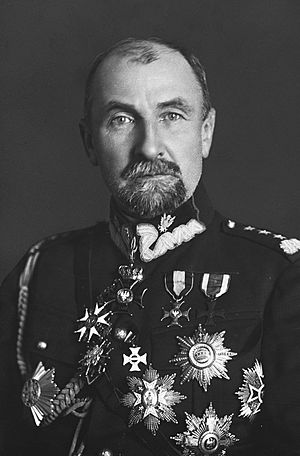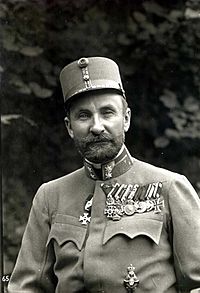Tadeusz Jordan-Rozwadowski facts for kids
Quick facts for kids
Tadeusz Jordan-Rozwadowski
|
|
|---|---|
 |
|
| Born | 19 May 1866 Babin, Galicia, Austria-Hungary |
| Died | 18 October 1928 (aged 62) Warsaw, Poland |
| Allegiance | |
| Service/ |
|
| Years of service | 1886–1926 |
| Rank | Chief of the General Staff |
| Battles/wars | First World War Polish–Ukrainian War Polish–Soviet War |
| Awards | |
| Signature | |
Count Tadeusz Jordan-Rozwadowski (born May 19, 1866 – died October 18, 1928) was an important Polish military leader. He was also a diplomat and a politician. He served as a general first in the Austro-Hungarian Army and then in the Polish Army.
Biography of a Polish General
Early Life and Family History
Tadeusz Jordan-Rozwadowski was born in Babin, a town near Kałusz. This area was part of Galicia, which belonged to the Austrian Empire. His family was part of the Polish nobility, known as szlachta. They were part of the Traby clan. In 1783, his family received the title of count from Emperor Joseph II.
Tadeusz came from a family with a long history of military service. The 'Jordan' part of his name comes from a very old ancestor. This ancestor was the first Pole to see the Jordan River during the Third Crusade. His great-grandfather, Kazimierz Jordan-Rozwadowski, was a general who fought against the last division of Poland. His grandfather, Wiktor, fought in the November Uprising and received a special military award. His uncle and father also fought in Polish uprisings.
Serving in the Austro-Hungarian Army
Before World War I began, Rozwadowski joined the Austro-Hungarian Army. He became an artillery officer. Artillery uses large guns to fire shells over long distances. For many years, he worked as a military attaché in Bucharest, Romania. This means he was a military expert working at an embassy.
In 1914, he was put in charge of the 12th Artillery Brigade. He was a skilled leader. He later commanded the 43rd Infantry Division. He led this division during the successful battle of Gorlice. For his bravery in this battle, he received the Military Order of Maria Theresa. He also helped create a new artillery tactic called Feuerwaltze, or "Fire-roller." In the Austro-Hungarian Army, he reached the rank of Feldmarschalleutnant, which is a high general rank.
Joining the Polish Forces
On October 26, 1918, Rozwadowski became the chief of staff for the Polnische Wehrmacht. This was a military force created before Poland became fully independent. After Poland regained its independence, he resigned from that role. A week later, he took on the same job for the new Polish Army.
Until March 19, 1919, he also commanded the Polish Eastern Army. This army was fighting in the Polish-Ukrainian War in Galicia.
Leading Polish Military Missions Abroad
After his service in Poland, General Rozwadowski went to Paris. There, he was part of the Polish group at the Peace Conference. He was one of the people who signed the Versailles Peace Treaty. This treaty officially ended World War I.
He also led many Polish military missions to Paris, London, and Rome. In June, he became the official representative of the Polish armed forces in Paris. He helped Poland get international support. For example, he helped get volunteers for the Polish-American Kościuszko Squadron.
Chief of Staff During the Battle of Warsaw
During the Polish-Soviet War, the Bolshevist Russian army launched a big attack. On July 22, 1920, General Rozwadowski returned to Poland. He became the Chief of General Staff again. He also joined the State Defence Council.
Historians discuss how much he helped create the plan for the Battle of Warsaw. This battle was very successful and changed the course of the war. It is sometimes called the "Miracle on the Vistula" river. Some historians believe his ideas were even more important than those of Marshal of Poland, Józef Piłsudski. Piłsudski is often given the most credit for winning the war. For his role in the war, Rozwadowski received the Virtuti Militari award (two different classes) and the Cross of the Valorous four times.
After the war ended, he became the inspector-general of Polish cavalry units. He also wrote a new plan in 1924 for how cavalry should fight and be organized. He was also one of the first people to support using tanks and airpower in the Polish army. In March 1921, he used his connections in Bucharest to help start the Polish–Romanian alliance. He helped negotiate a "Convention on Defensive Alliance" between the two countries.
After the May Coup

During the May Coup d'État in 1926, General Rozwadowski commanded the forces loyal to the legal government. He became the military governor of Warsaw. After Józef Piłsudski's forces won, Rozwadowski was arrested on May 15, 1926. He was taken to a military prison in Wilno (Vilnius). He was held there in difficult conditions for over a year, until May 18, 1927.
During this time, newspapers spread untrue rumors about him. They said he had done improper financial dealings while in the army. However, these accusations were never proven.
Death and Later Recognition
Soon after he was released from prison and retired, General Rozwadowski died in a hospital in Warsaw. There were rumors that he had been poisoned. He was buried with full military honors at the Łyczaków Cemetery in Lwów (Lviv). He was buried among the soldiers who died in the 1918–1919 Polish–Ukrainian War.
For many years after his death, the official Polish media tried to make people forget about Tadeusz Rozwadowski. This continued even after World War II under communist rule. Only after communism ended in Poland could historians study his life and his contributions to Poland's history fairly.
General Rozwadowski's Family
General Rozwadowski had a wife, a daughter, and a son. Most of his money was lost in a business project. This project was meant to help the soldiers who fought under his command. His daughter, Melania Josefina, never married and died in the 1970s.
His son, Jozef, was also an artillery officer in the Polish Army. He also received the Virtuti Militari award. In the 1930s, he had to leave the army and move to the United States. This was because he continued to support groups in Poland that were against Piłsudski and for democracy. In the U.S., he worked as an engineer. He helped design the elevators in the famous Empire State Building. He also helped design the Polish Pavilion at the 1939 New York World's Fair and the 1964 World's Fair. He had one daughter, Melanie Josephine, one granddaughter, Calia Brencsons-Van Dyk, and one great-grandson, Joseph. They all live in the United States.
Honours and Awards
- Commander's Cross of the Order of Virtuti Militari (he had previously received the Silver Cross in 1921)
- Cross of Valour – four times
- Commander's Cross of the Order of Polonia Restituta
- Commander of the Legion of Honour (France)
- Grand Cross of the Order of the Crown of Romania
- Cross of Liberty, Class I (Estonia)
- Star of the Order of the White Lion
- Order of Maria Theresa Knight's Cross
- Grand Cross of the Order of Leopold with war decoration and swords
- Order of the Iron Crown 1st Class
- Order of Franz Joseph Officer
- Military Merit Cross 3rd Class with war decoration and swords
- Bronze Military Merit Medal with swords
- Long Service Cross for Officers
- 1908 Jubilee Cross
- 1898 Jubilee Medal
- Iron Cross 2nd Class
See also
 In Spanish: Tadeusz Rozwadowski para niños
In Spanish: Tadeusz Rozwadowski para niños


